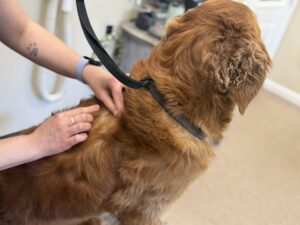
— As we transition out of the warmer months, the temperatures drop and the leaves fall, but tick activity actually increases. Throughout the summer, our grooming, daycare, lodging, and enrichment teams have all seen many unsuspecting pets fall victim to these hidden pests. Whether they are tucked deep under the fluffiest coats, hiding inside ears, or embedded between toe beans, ticks are relentless and can carry diseases that affect both pets and people.
At Golden Paws Pet Resort & Spa, we want our clients to feel prepared for situations like these, so here is what you need to know about tick prevention.
How Pets Pick Up Ticks
Ticks are not only a problem in wooded areas. They can be found in parks, backyards, and anywhere in nature, especially in areas with:
- Tall grass
- Leaf piles
- Wooded trails
- Overgrown shrubs
Even a quick potty break outside can be enough for a tick to hitch a ride.
Four Key Ways to Protect Your Pet
- Vet-Approved Medications
Topical or oral preventatives prescribed by your veterinarian are the most effective way to stop ticks before they bite. Many also protect against fleas and other parasites. - Tick Collars
These can be a good backup measure for pets who spend a lot of time outdoors. Ask your vet if a collar could be added to your pet’s prevention plan. - Daily Tick Checks
After walks or outdoor play, run your hands over your pet’s body and check:
- Inside and around ears
- Between toes
- Under the collar
- Under the tail
- Around the eyelids
- Yard Maintenance
Keep grass trimmed, remove tall weeds, and clear away leaf piles to make your yard less appealing to ticks. The fewer hiding spots you give them, the less likely they are to show up.
What to Do If You Find a Tick
- Use clean tweezers or a tick removal tool.
- Grasp the tick as close to the skin as possible and pull straight out without twisting. Make sure the head is still attached to the body upon removal.If the head detaches, your pet’s body will likely expel it on their own, but it is important to keep the area clean and monitor it for redness, swelling, or pus. If any of these signs develop, consult your veterinarian.
- Place the tick in rubbing alcohol or a sealed bag.
- Clean the bite area with soap and water.
- If you are unsure whether the tick was fully removed or your pet is acting differently than usual, contact your veterinarian.
Tick Season Is Not Just Summer or Fall
Ticks can be active in temperatures as low as 35°F. Year-round prevention is the safest choice, even when it is cold outside.
Keeping Your Pup Happy and Healthy
When it comes to parasites, prevention is always the best protection. The only thing your pup should be bringing home from their adventures is a wagging tail and maybe a good stick.
If you are not sure which tick prevention method is right for your dog, our team is happy to help. Just ask during your next visit or give us a call.
